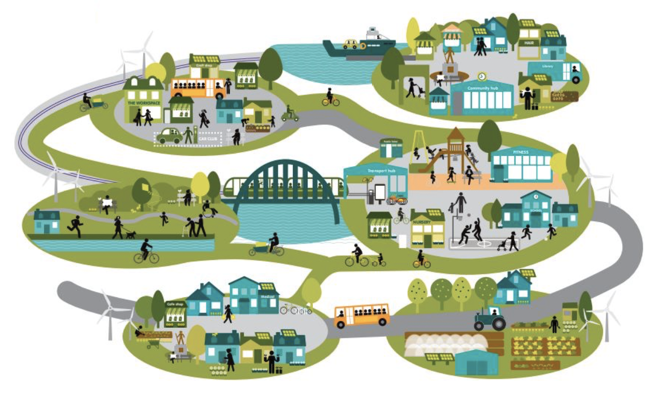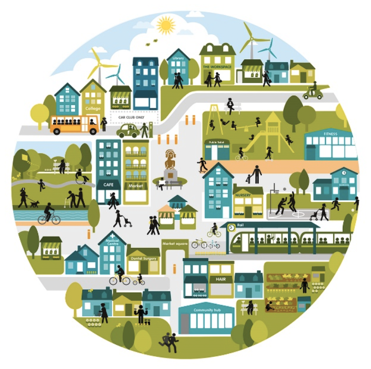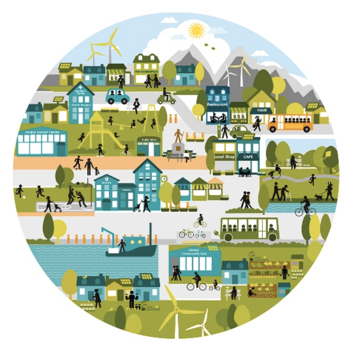Local living and 20 minute neighbourhoods: planning guidance
The guidance on local living and 20 minute neighbourhoods aims to encourage, promote and facilitate the application of the Place Principle and create connected and compact neighbourhoods which prioritise environmental, social and economic sustainability.
Part 1 - why local living
Key outcomes
We live in diverse geographies, from islands to coasts, rural areas, towns, and cities. Our diverse places - their landscapes and local settings, their infrastructure, services and facilities, and the local community - shape how we live day to day. This will affect our health, wellbeing, and impact on the planet.
Places with high quality housing, supportive local infrastructure, services, employment, education, and sustainable travel options, can help to break cycles of disadvantage and poverty, promote healthy lifestyles, and support physical, social, and mental health and wellbeing. They can also help support thriving local economies and community wealth building.
Good place design and management will strengthen local ability to manage environmental and other emerging challenges and to protect the environment. Research undertaken by ClimateXChange[2] tells us that in Scotland, 20 minute neighbourhoods could support positive outcomes around:
- climate actions
- health inequalities
- local economy
- liveability and quality of life

(source: O'Gorman & Dillon-Robinson (2021))
Climate action
Local living and 20 minute neighbourhoods can help our built environment to respond to the climate and nature crises and can play an important role in balancing our relationship with nature and the environment. Providing good quality opportunities to walk, wheel, cycle, or travel by sustainable means, to the places we need to access most regularly, can help to reduce the reliance on private car use. This can help to cut emissions, improve air quality, and encourage the repurposing of land to create greenspace which is good for our wellbeing as well as being good for nature and biodiversity.
Local living can also support opportunities for community food growing and local enterprises, reducing the carbon and environmental footprint of the food we eat and the goods we buy, and increasing the resilience of our supply chains.
Local living approaches increase opportunities for re-using and adapting existing buildings and places. The integration of blue and green infrastructure in our new and existing places will help communities to better manage the effects of climate change and extreme weather on communities and assist with nature restoration and biodiversity enhancement.
Re-using existing buildings can form part of a whole lifecycle emissions approach to development, avoids emissions from building new, and makes use of the embodied energy already within the building materials. Improving the energy efficiency of existing buildings reduces the emissions created by them now and into the future.
Reduced health inequalities
The World Health Organisation[3] definition of health is 'a state of complete physical, mental and social well-being and not merely the absence of disease or infirmity'. The places where people live, work and play can create and nurture, or be harmful to, health and are a key part of the wider environmental influences on health, at an individual and community level.
Health inequalities[4] are the unjust and avoidable differences in people's health across social groups and between different population groups. The fundamental causes of inequalities are the unequal distribution of power, income, and wealth. These inequalities can then influence the wider environment in which people live and work, and in turn shape their individual experiences and health.
Physical, social, and mental health and wellbeing can be supported by planning for local living. Having easy access to the services and support needed in our daily lives such as good homes, education, childcare, access to a variety of healthy and affordable food, feeling safe, having community cohesion, and protection from exposure to environmental harms such as pollution, flooding, excess heat or cold are some of the aspects of local living that impact on health inequalities. In addition, access to attractive, green, nature rich places impacts on health outcomes: encouraging people to meet, be active, play, and get around by walking, wheeling, and cycling.
Research[5] has evidenced that when addressing health inequalities, it is important to understand whether amenities and facilities meet the needs of the local population in a way that is accessible to them. Part 2 and 3 of this guidance aims to assist the consideration of this.
Improved local economy
Active and vibrant local centres are important not only in the services and facilities that they provide to the community, but also in terms of the employment and training opportunities that they offer. Places that are designed for local living can help to focus activity in local centres, providing important footfall and helping to sustain existing business as well as encouraging new enterprise and community wealth building. Approaches to local living seek to redevelop brownfield, vacant and derelict land, helping to bring land back into permanent or temporary productive use, encouraging investment in our communities.
Improved liveability and quality of life
Having local access to the things we need most regularly supports a positive quality of life for people in their local areas. Our connection with our places goes beyond the physical environment, forming part of our identity.
Places that are well designed feel welcoming and can encourage everyone to interact more with their surroundings and with each other. Providing the conditions for a good quality of life can help to combat social isolation and loneliness, delivering outcomes at social, environmental, and economic levels.
The policy context for local living and 20 minute neighbourhoods
The policy framework for local living and 20 minute neighbourhoods is complex and interlinked. Setting the policy context is essential to promote change in how we bring spatial and community planning together to improve health and wellbeing outcomes for the population.
The National Performance Framework, the United Nations Sustainable Development Goals (UNSDGs) and NPF4 all recognise that the places where we live and spend our time have a direct impact on health and wellbeing, quality of life and environmental balance.
NPF4 sets out a series of spatial principles for Scotland towards 2045: Just Transition, Local Living, Compact Urban Growth, Rebalanced Development, and Rural Revitalisation. These spatial principles support the planning and delivery of 'Sustainable Places', 'Liveable Places', and 'Productive Places'.
Creating places that support local living and 20 minute neighbourhoods will play an important role in contributing to national and global sustainability outcomes.
National Planning Framework 4
National Planning Framework 4 (NPF4) sets a clear policy agenda throughout the document that encourages local living and 20 minute neighbourhoods. Although delivering local living requires wide consideration of NPF4 principles and policies, specific intent and outcomes of the policy are set out in NPF Policy 15, as follows:
Policy Intent:
- to encourage, promote and facilitate the application of the Place Principle and create connected and compact neighbourhoods where people can meet the majority of their daily needs within a reasonable distance of their home, preferably by walking, wheeling, cycling, or using sustainable transport options
Policy Outcomes:
- places are planned to improve local living in a way that reflects local circumstances
- a network of high-quality, accessible, mixed-use neighbourhoods which support health and wellbeing, reduce inequalities, and are resilient to the effects of climate change
- new and existing communities are planned together with homes and the key local infrastructure including schools, community centres, local shops, greenspaces, health and social care, digital, and sustainable transport links
The delivery of NPF4 is supported by a wider programme of planning reform that will contribute towards local living and 20 minute neighbourhoods. The principles of local living and 20 minute neighbourhoods are also embedded in a range of wider Scottish Government policy initiatives including Housing to 2040, Town Centre Action Plan, Getting the Right Change - A Retail Strategy for Scotland and NTS2 National Transport Strategy.
Design, quality, and place - The six qualities of successful places
Creating Places is Scottish Government policy statement on architecture and place, setting out the comprehensive value good design can deliver. The policy statement promotes good design and placemaking through the principles of context, identity and character and sets out the six qualities of successful places as guiding principles.
The six qualities of successful places are set out as:
- healthy
- pleasant
- connected
- distinctive
- sustainable
- adaptable
Details on delivering the six qualities of successful places are set out in Annex D of NPF4.
Public service reform
Public services touch on many aspects of everyday life – including health, social care, education, early years, community justice, enterprise, and skills – and play a crucial role in ensuring people's wellbeing. Integration, collaboration, and a shift towards prevention are key elements of the public service reform agenda. The long term and holistic approach of good placemaking and local living provides planning with an opportunity to support public service reform and improve outcomes for communities.
To achieve this, collaborative working across and between all sectors is required.
Place context
Creating the conditions for local living requires a holistic focus on understanding and creating good places that support healthy, sustainable lifestyles, not simply on the development and allocation of land.
Our places are individual and unique with their own history, assets, characteristics, and identity. They comprise diverse communities with unique characteristics, challenges, and aspirations. The context of each place is central to designing and delivering interventions that supportlocal living. This means understanding the needs, aspirations, and interests of the community as well as the physical, social, cultural, and economic context.
Thinking about the interrelationships between these elements, and how local people perceive them, is central to developing a coherent framework to deliver successful local living.
The Place Principle
The Place Principle provides the overarching basis for place-based working, by encouraging a participative approach to planning places, services, infrastructure, land uses, and buildings. It encourages collaborative partnership working with a range of stakeholders, including local communities and community groups, businesses, transport providers, healthcare, and education providers, and across local authority structures.
A wide range of stakeholders and agencies likely to be involved in the process of preparing LDPs is provided in the Scottish Government's Local Development Planning Guidance, and may be a helpful reference.
What does the Place Principle say?
Place is where people, location and resources combine to create a sense of identity and purpose and is at the heart of addressing the needs and realising the full potential of communities. Places are shaped by the way resources, services and assets are directed and used by the people who live in and invest in them.
A more joined-up, collaborative, and participative approach to services, land, and buildings, across all sectors within a place, enables better outcomes for everyone and increased opportunities for people and communities to shape their own lives.
The principle requests that:
All those responsible for providing services and looking after assets in a place need to work and plan together, and with local communities, to improve the lives of people, support inclusive and sustainable economic growth and create more successful places.
Community engagement
Engaging with communities is integral to the Place Principle and vital for delivery of local living and 20 minute neighbourhoods that support quality of life. The National Standards for Community Engagement are good-practice principles designed to improve and guide the process of community engagement. Furthermore, collaborative working between key local partners such as spatial planning, community planning, health and social care, third sector may also offer opportunities to share and streamline community engagement, or to draw on existing consultation findings. Each partner has a role in the delivery of local living and should be working to the Place Principle.

In rural and island areas, distances and densities mean flexibility and innovative approaches are required to support living well locally. It is possible to support local living through planning for connected, attractive, sustainable places that respect the character and context of rural settings.

Where populations and services are distributed more widely, a networked approach can support local living within settlements. It is important to consider the relationships between settlements as well as the individual place. Local hubs with good transport links and improved digital infrastructure and connectivity can provide local employment opportunities, support remote and home working and technology-enabled or remote services, helping to reduce the need for rural communities to travel longer distances and the associated costs, time, and environmental impact.
Joined-up planning and development design approaches that provide sustainable access to the majority of the daily needs for a wider community can help to support quality of life in rural and island communities. It can also increase opportunities for business, provide well-connected housing, enhance local character, and reduce transport costs. Local input and participation will be important in shaping what local living looks like in rural and island areas, supporting finding the right solutions that offer climate conscious and sustainable approaches.
Across rural and island areas, there are many examples of projects supporting local living principles. This study, Living Well Locally, 20 Minute Communities in the Highlands and Islands, commissioned by HITRANS looks at what a 20 minute neighbourhood could be like in a rural and island context. It considers what would need to happen for a rural settlement to become a 20 minute community.
Urban contexts
While most of Scotland is rural, the majority of the Scottish population lives in areas that are considered urban in nature. The principles of local living, in particular the 20 minute neighbourhood approach, may be more easily achievable where there are generally higher population densities like those found in urban areas.

Smaller scale settlements may have their own local centres and strategies to support local living. However, they may also benefit from access to larger urban areas, providing additional specialised services and large-scale infrastructure.


In addition, a settlement in one place may rely on a centre or the services that are located within a neighbouring local authority boundary. Consideration of local context and behaviour may highlight the need to plan across boundaries to work together as part of a larger network, providing access to specialised services across communities while benefiting from access to large scale infrastructure such as hospitals, universities, transport interchanges and cultural offerings found in cities.
The Town Centre First principle is complemented by local living and 20 minute neighbourhood approaches. Living locally can contribute to strengthening local economies, increasing local population, and encouraging footfall, all of which improves the vibrancy and vitality of town centres.
Infrastructure for local living
Transport infrastructure, the locations of new housing developments, and anchor institutions[6] are key components in planning for local living. Transport infrastructure, including active travel and public transport, operates at national, regional, and local scales.
Infrastructure models where services are centralised or shared can create efficiencies, but there can also be unintended consequences on communities fulfilling their daily and wider needs in a sustainable way. Decision making around the locations and models of services, such as those for education, healthcare, leisure, community infrastructure, and housing can help to underpin local living.
Local living requires consideration to be given to the wider implications of decisions around the location of anchor institutions on our town, city, and neighbourhood centres. This may include the ability of the community to travel sustainably and actively to a destination, and any impacts on health and wellbeing, equalities, community cohesion and interaction. It may also include consideration of any unintended and/or adverse impacts of locating anchor institutions and housing on sites that are remote from centres of activity or that are severed from the nearby community by existing or planned infrastructure.
A sound understanding of planned and future transport investment at all scales is crucial in informing decisions about locations of housing, other key infrastructure and anchor institutions that support local living, in line with NPF4 Policy 18 - Infrastructure first.
LDP preparation requires consistent, early engagement and collaboration between relevant stakeholders, across sectors and with local authority client departments. Information about the infrastructure first approach and local development planning can be found in the Local Development Planning Guidance.
By applying local living principles to decisions about service provision, adverse impacts can be minimised. One method of assessing the impacts of development on a place is illustrated in the Improvement Service's Rapid Scoping Assessment that considers the impacts of the North Shore Development Framework on the wellbeing of those who live, work, play and learn in Ardrossan.
Contact
Email: chief.planner@gov.scot
There is a problem
Thanks for your feedback